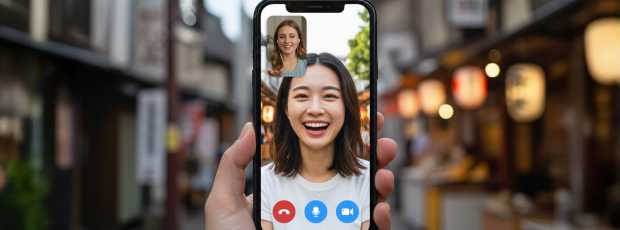Vanessa’s knowledge of Kyoto and friendly demeanour!Dawn, Kyoto, 2025
Table Of Contents
- Temples That Still Feel Like Sacred Hidden Gems
- Explore Kyoto's Forgotten Castles and Shrines
- Slightly Off the Beaten Path: Ponto-chō After 10 PM
- Kennin-Ji's Art You Won't Forget
- Tranquility at Daigo-Ji
- Nagaoka Tenmangu's Azaleas
- Festivals Most Tourists Miss
- Hidden Spots: Kyoto's Unlisted Gardens
- Tea Culture Away from Tourist Areas
- Walks That Lead Somewhere New
- Two Low-Crowd Kyoto Routes (No Checklist Energy)
- Day Trips Locals Recommend
- What to Skip (If You Want Kyoto to Feel Quiet)
- Kyoto's Everyday Charms
- Getting Around Kyoto
- What I Hope You'll Take Away
I was born here in Kyoto Prefecture. Raised in these narrow streets. But for years, I found myself caught in the same tourist flow, moving from temple to temple like everyone else. When I say ‘non-touristy,’ I don’t mean secret coordinates. I mean Kyoto at quieter hours, on side streets, and in places that reward slowing down, even when they’re close to famous sights.
The breaking point came during cherry blossom season three years ago, when I couldn’t even see the sakura at Maruyama Park through the sea of selfie sticks, surrounded by the bustling crowds that dominate Kyoto’s most popular spots.
That’s when I decided to rediscover my own city. To find the most unique things to do in Kyoto that locals actually treasure. What I found changed how I see this place entirely. And that's what I want to share with everyone who wants to visit my city.
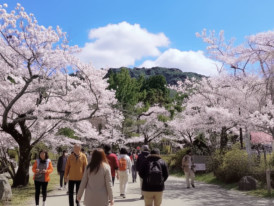
Cherry blossom crowds packed in Maruyama Park
Most visitors hit Kyoto hard on their first trip: Kiyomizu-dera (清水寺), Fushimi Inari Shrine (伏見稲荷大社), and the bamboo grove in Arashiyama. These places deserve their fame. But by your second visit, or even halfway through your first, you’re ready for something deeper. You want to explore Kyoto beyond the postcards and look for experiences that feel more connected to real life here. If you’re planning your first trip, our guide to Japan for first-timers will help you pace your days before you zoom in on Kyoto.
The city rewards patience. Step away from the beaten path, and you’ll find quieter places that reveal why we locals never tire of living here. Such places are often overlooked by visitors but cherished by those who know their quiet beauty. They aren’t secret spots; they’re overlooked because they require intention rather than impulse.
Here are my favourite things to do in Kyoto when you want the city to feel quieter and more personal.
Temples That Still Feel Like Sacred Hidden Gems
Otagi Nenbutsuji Temple: Where Moss Tells Stories
In far western Arashiyama, at the foot of Mount Atago, sits Otagi Nenbutsuji Temple (愛宕念仏寺). It’s one of those hidden gems in Kyoto that stays quiet even in busy seasons. About 1,200 stone rakan statues populate these grounds, each carved by a different hand. Moss creeps across their faces. Rain has softened their features. Time has made them more beautiful, not less.
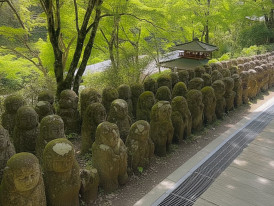
Moss covered stone statues lined along a path at Otagi Nenbutsuji Temple
I come here when Kyoto feels overwhelming, and I want to see a natural wonder with human influences. The statues seem to hold conversations across centuries. Some smile, others meditate with closed eyes, and a few look directly at you with expressions that feel almost human.
Kodai-ji's Forgotten Bamboo Grove
Everyone knows about Arashiyama’s bamboo grove. Tour groups arrive by the busload. But in the heart of Higashiyama, Kodai-ji Temple (高台寺) has its own bamboo forest that most people walk right past.
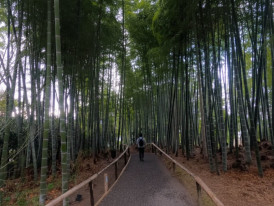
Path through Kodai-ji’s bamboo grove with tall green stalks
The path winds uphill behind the main temple buildings. Bamboo stalks tower overhead, creating that distinctive green light that filters down like an underwater sunbeam.
But here, you can actually hear the bamboo creaking in the wind. You can stop to photograph the patterns without someone photobombing your shot.
Daruma-dera: Where Wishes Take Physical Form
Hōrin-ji Temple (法輪寺), better known as Daruma-dera (達磨寺) (not to be confused with the Hōrin-ji in Arashiyama), sits in a quiet residential area northwest of central Kyoto. The temple specializes in daruma dolls; those round, red figures that represent perseverance and goal-setting in Japanese culture. But this isn't your typical souvenir temple.
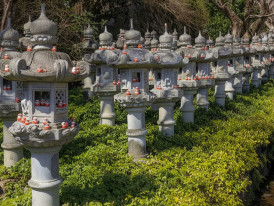
Weathered daruma dolls scattered across temple grounds
The grounds are scattered with about 8,000 daruma dolls left by visitors over the decades. Some are tiny, others are massive. The weather has faded their red paint to soft pink. Eyes painted on successful wishes peer out from every corner.
Private Kyoto Experiences That Fit This Vibe
If you want help keeping it calm — early starts, quieter streets, and the right detours — browse a few ways to shape a private day.
Explore Kyoto's Forgotten Castles and Shrines
Fushimi Momoyama Castle: Echoes Without Crowds
Most visitors to the Fushimi sake district never climb the hill to Fushimi Momoyama Castle. The current structure is a concrete replica built in 1964, which puts off history purists. The interior has been closed since 2003, so you’re visiting mainly for the hilltop grounds and the views. But that misses the point entirely. The castle sits alone on its hilltop, surrounded by cherry trees that bloom in spectacular solitude each spring.
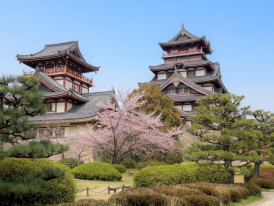
Fushimi Momoyama Castle on a quiet hilltop framed by blooming cherry trees
From the grounds, you can see across the Uji River valley to the mountains beyond. The city spreads below, but feels distant. Visiting Fushimi Momoyama Castle makes for an excellent day trip for those wanting to explore beyond Kyoto and discover a less crowded, culturally rich site.
Mikane Shrine: Gold Hidden in Plain Sight
Tucked between shops near Nijo Castle stands Mikane Shrine (御金神社), dedicated to the god of metal and money. The torii gates are painted brilliant gold. Metal offerings hang from every available surface, coins, keys, and small metal objects left by hopeful visitors.
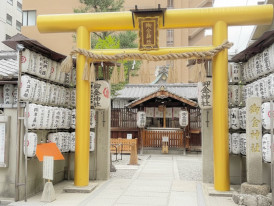
Gold torii at Mikane Shrine in morning light
The shrine occupies a tiny lot, barely larger than a convenience store. But the gold torii gates create an almost surreal gateway effect. Step through them, and the busy street disappears. The space feels separate from the world around it. It’s not empty, but it’s quickest and calmest in the early morning or just before dinner, when people stop by briefly rather than linger for photos.
Slightly Off the Beaten Path: Ponto-chō After 10 PM
Every guidebook mentions Ponto-chō, that narrow alley between Kawaramachi and the river. But they tell you about the expensive kaiseki restaurants and curated bars that cater to tourists. The real Ponto-chō emerges after 10 PM, when the suits come out for their second round of drinks.
Slip down the side alleys that branch off the main strip. These darker passages hide standing bars no wider than a closet, where salarymen drink highballs and swap stories late into the night. The mama-san knows everyone's name and their preferred poison.
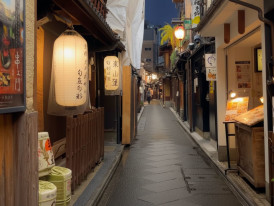
Narrow Ponto-chō alley at night with glowing lanterns
In a yokocho-style cluster of micro-bars, each seating may be six people. The bartenders are characters, former hostesses, ex-chefs, people with stories etched in the lines around their eyes. They serve whatever they feel like making, often based on your mood rather than your order. These places don't take reservations. English menus aren’t always available. They exist for regulars who understand that the best conversations happen in spaces too small for pretense.
If you want it to feel “non-touristy,” the trick is slowing down in the connected halls and smaller rooms, where most people don’t spend time.
Kennin-Ji's Art You Won't Forget
Kennin-Ji Temple (建仁寺) holds the title of Kyoto’s oldest Zen temple, founded in 1202. But most visitors rush through, focused on the famous twin dragons painted on the Dharma Hall ceiling.
These dragons are among the temple’s famous artworks, which also include other notable pieces like the sliding door paintings and the celebrated dragon ceiling. All highlight the artistic and cultural significance of Kennin-Ji. They miss the deeper artistry that makes this temple extraordinary.
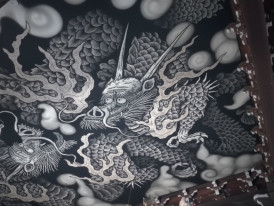
Twin dragon mural on the ceiling at Kennin-Ji
The dragon painting deserves attention… But step into the connected halls, and you’ll find ink paintings by masters whose names are forgotten but whose brush strokes capture wind and water with startling immediacy, a reminder of how deeply Zen Buddhism shapes artistic expression at Kennin-Ji. If you want it to feel “non-touristy,” the trick is slowing down in the connected halls and smaller rooms, where most people don’t spend time.
Tranquility at Daigo-Ji
Daigo-Ji Temple (醍醐寺) sits on Mount Daigo’s slopes, far enough from central Kyoto to discourage casual visitors. The temple complex spreads across multiple levels, connected by walking paths that wind through forest and clearings. The lower areas center around a pond that perfectly reflects the surrounding buildings and seasonal foliage.
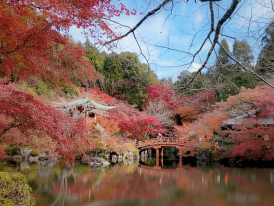
Still pond at Daigo-Ji reflecting seasonal trees and temple buildings
In spring, cherry trees create pink clouds above the water. Fall brings maple reflections so vivid they seem painted. Winter snow transforms the scene into a monochrome meditation. This area is a beautiful garden, offering tranquility and seasonal beauty away from the crowds.
Because No Two Travelers Are the Same
We help you shape a city day that matches your pace, your style, and your curiosity, not a fixed route.
Find out howNagaoka Tenmangu's Azaleas
Southwest of Kyoto, Nagaoka Tenmangu Shrine (長岡天満宮) specializes in academic success; students pray here before exams, and parents bring their children starting school. But the shrine’s real glory comes in late spring, when the approach bursts into bloom with rows of Kirishima azaleas. For flower lovers seeking a quieter, beautiful experience, Nagaoka Tenmangu is a quieter alternative to Kyoto’s more crowded spots.
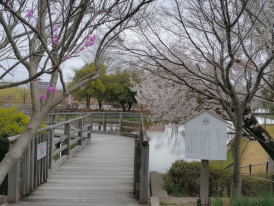
Wooden walkway winding through Nagaoka Tenmangu
The azalea garden feels like walking through colored clouds. Pink, white, red, and purple flowers create layers of color that shift with each step. Wooden walkways wind through the bushes, creating intimate spaces where you can sit surrounded by blooms.
Festivals Most Tourists Miss
Kurama Fire Festival: Ancient Fire on Mountain Paths
Each 22 October, the mountain village of Kurama transforms into something from Japan’s ancient past, one of those Japan experiences that stays with you long after you leave. The Kurama Fire Festival begins at sunset, when young men carry massive torches through narrow village streets, chanting “Sairei ya, saiyo” in voices that echo off wooden buildings.
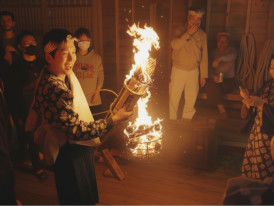
Carrying giant flaming torches through the streets of Kurama fire festival
The festival honors the fire god and celebrates the community’s connection to the mountain that shelters them. Torches range from small hand-held flames to enormous structures requiring teams to carry. As darkness falls, the entire village glows with moving fire.
Aoi Matsuri: Elegance in Motion
The Aoi Matsuri (Hollyhock Festival) on 15 May represents court elegance from the Heian period. Its main procession starts at the Kyoto Imperial Palace and continues to Shimogamo Shrine, then on to Kamigamo Shrine.
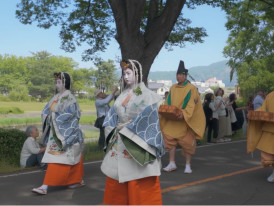
Silk-robed procession moving slowly during Aoi Matsuri in Kyoto
Unlike the energetic festivals that draw international attention, Aoi Matsuri emphasizes graceful movement and aesthetic perfection. Ox-drawn carts decorated with hollyhock and wisteria flowers create moving art installations. Court musicians play instruments that haven’t changed in a thousand years.
Go Deeper With a Local
City Unscripted pairs you with someone who knows the quiet paths and hidden corners, so every walk feels personal and flexible.Hidden Spots: Kyoto's Unlisted Gardens
Shoseien Garden: Pocket Paradise
Behind Higashi Honganji Temple (東本願寺) hides Shoseien Garden, a masterpiece of landscape design that most visitors never discover. The garden occupies a full city block but feels like a separate world, with ponds, bridges, and walking paths that create constantly changing views.
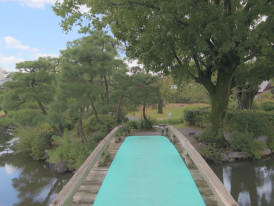
Pond and arched bridge Shoseien Garden
The garden demonstrates classic Japanese landscape principles, borrowed scenery, seasonal focus, and multiple viewing perspectives from a single design. Every step reveals new compositions of water, stone, and plant life that work together like three-dimensional paintings.
Nanzen-in Garden: Hidden Within Hidden
Inside the already peaceful Nanzen-ji Temple (南禅寺) complex sits Nanzen-in Garden, a smaller building with its own moss garden that few visitors notice. The garden specializes in moss varieties that create subtle color gradations across stone and earth.
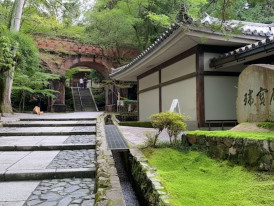
Moss garden with stone paths in the quiet Nanzen-in grounds
Moss growth requires specific conditions: the right amount of shade, moisture, and air circulation. Nanzen-in’s moss garden demonstrates how patient cultivation can create natural beauty that improves with age. Different moss species bloom at different times, creating seasonal color variations in dozens of shades of green. It stays calmest when you arrive right at opening or late afternoon, when the bigger Nanzen-ji complex thins out.
Tea Culture Away from Tourist Areas
Tea Houses in Residential Districts
If you want a quieter tea experience, look for small tea rooms in residential neighborhoods and plan ahead; many run on reservations and keep the atmosphere intentionally calm. A few practical cues before you go:
• Expect reservations (especially on weekends); check booking notes carefully.
• Aim for mid-morning or mid-afternoon for the calmest vibe.
• Assume minimal English and bring patience (simple phrases go a long way).
• Ask before taking photos; many spaces are etiquette-forward.
• Carry cash as a fallback.
In quiet residential areas near Kyoto's edges, traditional houses have been converted into intimate tea spaces. The owners often practice flower arranging alongside the tea ceremony, creating displays that change with each season and complement the specific teas being served.
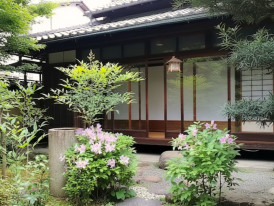
Small traditional tea house tucked into a quiet Kyoto street
Flower arranging (ikebana) in these settings emphasizes natural beauty over formal display. Arrangements might feature a single branch of cherry blossoms in spring, or autumn grasses that echo the tea's earthy flavors. The flowers and tea create unified aesthetic experiences.
Stylish Cafés in Unexpected Places
Modern Kyoto also harbors stylish cafés that locals frequent but tourists rarely discover. They combine traditional Japanese design sensibilities with contemporary coffee culture, creating unique environments for slower-paced exploration. Hidden in quiet areas, converted machiya (traditional wooden townhouses) now serve single-origin coffee and house-made pastries.
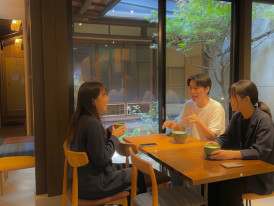
Cozy machiya café with wooden beams and locals sipping coffee in a quiet corner
These cafés attract local artists, writers, and professionals who need quiet spaces for focused work. The atmosphere encourages slow consumption, lingering over coffee, reading, or quiet conversation.
Wish You Could Just Ask a Local?
Book a quick video call and get insider answers to your trip questions.
Walks That Lead Somewhere New
Philosopher's Path: The Detours Matter Most
The Philosopher’s Path between Ginkaku-ji (銀閣寺) and Nanzen-ji attracts steady tourist traffic, but the side paths that branch off the main route lead to discoveries that most visitors miss. These detours wind through residential neighborhoods and connect to small temples that maintain their local character. Early morning walks along the main path provide solitude that afternoon visitors never experience. Midday is busy. The quiet version is sunrise or weekday mornings, plus committing to detours instead of treating it like a straight shot between famous endpoints.
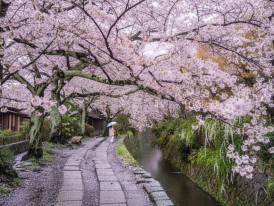
Path along a canal lined with cherry trees on the Philosopher’s Path
The path’s network of connecting routes creates opportunities for exploration beyond the famous endpoints. Small bridges cross the canal at regular intervals, leading to traditional neighborhoods where daily life continues around centuries-old temples and family shops. Side temples like Honen-in (法然院) offer quiet contemplation away from the main tourist flow. The approach to Honen-in through a grove of ancient trees creates a natural separation from the busier path.
For those seeking even more tranquility, consider visiting Gio-ji (祇王寺), a peaceful, lesser-known temple renowned for its moss gardens and serene atmosphere.
Kamogawa River at Sunrise
The Kamogawa River provides Kyoto’s most consistent source of natural beauty and peaceful walking, but most visitors only see the evening riverside dining areas in central districts. Early morning along the river reveals different characters in different sections.
North of the city center, the river flows through more natural settings where herons hunt in shallow water and cyclists follow paths that connect to mountain temples. The water runs clearer here, and the banks support wildlife that survives despite urban pressures.
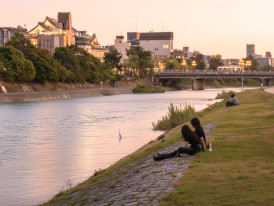
Soft sunrise light over the Kamogawa River
Southern sections near Fushimi offer wider paths and longer sight lines across agricultural areas that still exist within the city boundaries. These walks connect to historic areas like the Fushimi sake district while providing peaceful alternatives to busy streets. For those who need more scenic tranquility and outdoor activities, the Hozu River in nearby Kameoka is also known for its picturesque boat rides and beautiful natural surroundings.
Two Low-Crowd Kyoto Routes (No Checklist Energy)
Route 1: Sunrise to Slow Morning (2–3 hours)
- Start: Kamogawa River at sunrise
- Then: Walk toward the Philosopher’s Path, but take the side streets. Don’t stay on the main canal the whole way
- Quick stop: Honen-in (quiet approach, easy reset)
- Finish: Nanzen-ji area via the calmer edges (go for atmosphere, not “seeing everything”)
- Best for: First-time visitors who want Kyoto to feel gentle rather than busy
Route 2: Late-Night Kyoto (90 minutes, after 10 PM)
- Start: Ponto-chō main strip (quick pass-through)
- Then: Take the side alleys and duck into one standing bar or micro-bar cluster
- Finish: Slow walk back along the river to decompress
- Best for: People who want a lived-in Kyoto night without booking-heavy spots
Day Trips Locals Recommend
Uji: Beyond the Green Tea Tourist Trail
Everyone knows Uji for green tea, and the main tourist areas deliver exactly what guidebooks promise: tea shops, Byodo-in Temple (平等院), and crowds sampling matcha ice cream. But locals explore Uji differently, focusing on the river and the less commercial neighborhoods that support traditional craftsmen.
The Uji River supports cormorant fishing during the summer months, a practice that requires skill passed down through generations. Watching the birds work at sunset, diving for fish while tethered to wooden boats, connects directly to fishing methods used for over a thousand years.
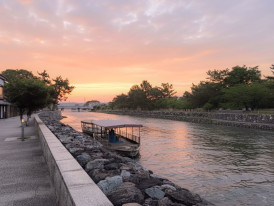
Boats on the Uji River at sunset
Away from the main tourist zones, small tea farms still operate on Uji's hillsides. Some welcome visitors who make appointments and show genuine interest in tea cultivation rather than casual sampling. Local recommendation: Visit in early autumn, when the tea harvest creates activity in the fields and workshops. The combination of seasonal work and fewer tourists provides optimal conditions for authentic cultural encounters.
Lake Biwa Canal: Engineering Meets Nature
The Lake Biwa Canal represents one of Japan's most ambitious 19th-century engineering projects, a waterway connecting Kyoto to Lake Biwa in neighboring Shiga Prefecture. Today, restored boats carry passengers along sections of the historic route, but the canal offers much more than scenic rides.
Walking the canal's full length reveals how Meiji-era engineers solved complex problems of elevation, water flow, and tunnel construction through mountains. The Keage Incline, where boats were hauled uphill on rails, demonstrates innovative solutions to geographic challenges.
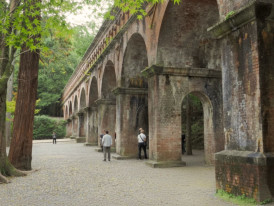
Stone aqueduct of the Lake Biwa Canal near Nanzen-ji Temple
The canal connects to Nanzen-ji Temple via an impressive aqueduct that carries water above the temple grounds. This intersection of modern engineering and ancient spirituality creates unique photographic opportunities and demonstrates Japan's ability to integrate old and new. Natural scenery along the canal changes dramatically between urban Kyoto and rural Shiga Prefecture.
The waterway passes through tunnels carved through mountains, emerges into valleys with traditional farming, and connects to Lake Biwa's expansive waters.
What to Skip (If You Want Kyoto to Feel Quiet)
- If you’re after the sound and feeling of bamboo, skip Arashiyama’s main grove between 10 AM–3 PM. Kodai-ji’s bamboo path is calmer, and any bamboo is better early.
- Don’t stack “one more temple” on top of an already full day. Choose one area (Higashiyama, Arashiyama edges, or Fushimi) and add one detour.
- Ponto-chō is at its most polished at dinner. For the lived-in version, go 10 PM onward and take the side alleys.
- During cherry blossom season, Maruyama Park gets swamped fast. If you actually want to see the sakura, go earlier, or use smaller neighborhood greenspaces and riverside walks instead.
- For short hops in traffic-heavy areas, buses can be slower than they look. Walking or biking along the river is often the quieter (and quicker) option.
- “Non-touristy” doesn’t mean secret. Most of the calm comes from timing and pace, not from hunting hidden coordinates.
Kyoto's Everyday Charms
Markets Near Kyoto Station That Guidebooks Miss
One genuinely local early morning option is the Kyoto City Central Wholesale Market’s Fisheries Market Visitor Area. If you want a genuinely local early morning, the Kyoto City Central Wholesale Market has a visitor/observation area where you can watch fisheries auctions (around 5:00–6:00 AM). The early morning market activity begins before dawn, when buyers for restaurants and shops select the day’s seafood. Even if you miss the auction window, the visitor area has exhibits on how the market works and Kyoto’s food culture. By around 7 AM, the fisheries floor is in full motion, buyers, carts, and calls moving fast.

Fresh produce at a small morning market stall
This market operates primarily in Japanese, creating cultural immersion for visitors willing to take on language barriers. It’s observation-first: arrive quietly, and expect most of the experience to be watching how the market works.
If you’re a food person, the seasonality shows up in what’s arriving on the fisheries floor, a quick snapshot of what Kyoto’s kitchens are cooking right now.
Residential Neighborhood Discoveries
Kyoto's residential neighborhoods maintain traditional architecture and community life that continues regardless of tourism. Walking these streets reveals how the city functions as a living community rather than a historical museum. Small shrines embedded in residential blocks serve local families who maintain them through community cooperation.
These neighborhood shrines lack the grandeur of famous temples but demonstrate how spiritual practice integrates into daily life for Kyoto residents.
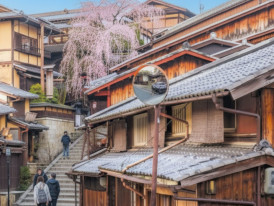
Old neighborhood in Kyoto
Traditional crafts continue in residential workshops where artisans create items for local use rather than tourist sales. Pottery studios, textile workshops, and woodworking shops operate in converted houses, preserving skills while adapting to contemporary needs.
Public bathhouses (sento) still serve neighborhoods where traditional houses lack modern bathing facilities. These community spaces maintain social functions that connect neighbors across generations.
Getting Around Kyoto
Kyoto is a city where the past and present move side by side, and getting around is part of the adventure. Locals know that the best way to explore the city isn’t by rushing from one famous site to the next, but by letting the city’s rhythm guide you.
The Kyoto City Bus system is a lifeline, weaving through neighborhoods old and new, and making it easy to slip from the bustle of downtown to the quiet of a temple garden. The subway, just two lines, but perfectly placed, connects you to the city’s heartbeats, from the businesslike hum of Kyoto Station to the leafy calm of the Tozai Line’s eastern stops.
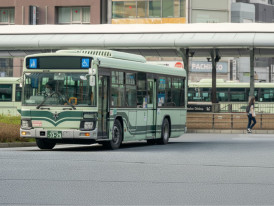
Kyoto City Bus
But to really feel Kyoto, rent a bike and follow the Kamogawa River as it winds through the city. In the Arashiyama area, pedal beneath the arching green of bamboo. Whether you’re gliding past shrines or pausing to watch the river sparkle, you’ll see why locals cherish these simple ways to move through Kyoto’s ever-changing landscape.
Buses, Bikes, and the Joy of Getting Lost
Some of Kyoto’s most memorable moments happen when you step off the main road and let curiosity lead. Hop on a city bus bound for northern Kyoto, and you’ll find yourself in neighborhoods where the pace slows and the crowds thin.
Wandering on foot or by bike here, you might stumble upon a serene temple like Eikando (永観堂), its quiet halls echoing with centuries of prayer, or discover the tranquil beauty of a garden hidden behind unassuming walls.
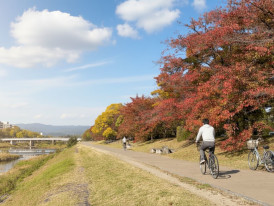
Cyclist following a quiet riverside path in Kyoto with morning light on the trees
The city’s hidden areas reveal themselves to those willing to get a little lost. Don’t hesitate to ask a shopkeeper or passerby for a recommendation. If you’re unsure, ask a café owner or shop staff what’s worth seeing nearby. You’ll often get a small, practical suggestion rather than a ‘top sights’ answer.
You might find yourself at Kennin-ji, the oldest Zen temple in Kyoto, or in a neighborhood shrine where incense drifts on the morning air. Every detour is an invitation to slow down and see the city as locals do: not as a checklist of temples and shrines, but as a living, breathing place where every street holds a story.
Seeing Quiet Backstreets
Kyoto’s quiet backstreets are where the city’s true character comes alive. Here, away from the main avenues, you’ll find stylish cafes tucked into old machiya townhouses and traditional tea houses where time seems to pause.
To make the most of these tucked-away spots, pick up a prepaid IC card like ICOCA or SUICA; your key to seamless travel on buses and trains. A good mapping app helps, but sometimes the best discoveries happen when you put the phone away and simply wander.
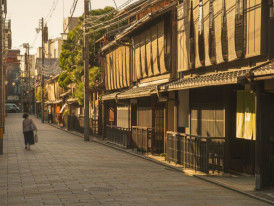
Kyoto backstreet with old wooden houses and soft afternoon light
As you meander through these narrow lanes, keep an eye out for beautiful gardens like Nanzen-in, especially breathtaking when autumn colors set the moss and maples aglow. The backstreets are dotted with small temples, artisan workshops, and cozy spots where locals gather over tea or coffee.
With patience and a spirit of exploration, you’ll experience a side of Kyoto that most tourists miss, a city where tradition and modernity blend quietly, and every turn offers a new perspective on what it means to truly explore Kyoto.
What I Hope You'll Take Away
These places exist because people choose to maintain them. The temples survive because monks continue daily practice. The festivals happen because communities value their traditions. The hidden spots stay beautiful because visitors treat them with respect.
Kyoto rewards slow exploration and repeat visits. Each season reveals different aspects of familiar places. Every return visit deepens understanding of connections between past and present. The city's layered complexity unfolds over time rather than revealing itself immediately.
My hope is that you'll find your own quiet favourites; places that speak to you personally rather than Instagram-ready spots that impress others. The best Kyoto experiences create a deeper connection rather than a simple accumulation of famous sights.
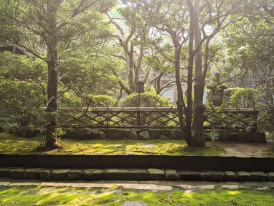
Sunlit temple garden path in Kyoto with moss and trees
Kyoto has room for millions of visitors, but it rewards those who approach with patience and respect for the communities that maintain its beauty. Choose quality over quantity. Stay longer in fewer places. Notice details that reveal personality and history.
Kyoto reveals more when you slow your pace and follow the rhythms of everyday life here. The most meaningful experiences tend to happen when you move more slowly, stay longer in one place, and pay attention to how people actually use these spaces. In practice, that often means visiting earlier in the day, choosing fewer places, and letting neighborhoods guide your route rather than famous landmarks.
These places to visit in Kyoto represent starting points for your own discoveries.
Return to the places that move you. Observe how they change with seasons and time. Develop relationships with locations that go beyond single visits. That’s when visits stop feeling rushed and start feeling personal, and Kyoto’s quieter side begins to make sense.
Discover More Of Japan
Ready to Plan Your Perfect Day in Kyoto?
Start your experienceHow to Explore Kyoto Without “Checklist Energy”
A private experience with a local host can help you time it right, take the detours, and keep the day calm — planned in advance, flexible in the moment..
Want to Experience the Real Milan With Someone Who Lives There?
A fully private experience, planned and led by a local host who tailors the day to you





